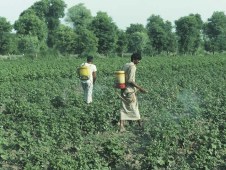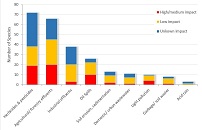
Pollution affects species directly, leading to mortality (in 6% of globally threatened birds) or reduced reproductive success (in 3%), as well as indirectly, through the degradation of habitats (affecting 11%). Pollution associated with agriculture, forestry and industry is the most common threat, and has the greatest impact on marine and freshwater environments and the species that depend upon them.

Pollution directly impacts 7% of threatened bird species through mortality and 3% through reduced reproductive success. Indirectly it leads to habitat degradation which affects 11% of all threatened bird species (analysis of data held in BirdLife’s World Bird Database 2016).
The major pollutants are effluents: from agriculture, forestry, industry, oil spills and the over-application of herbicides and pesticides (see figure). Effluents cause the greatest damage to aquatic environments and affect the species that depend upon them disproportionately. Of the 218 threatened bird species affected by one or more pollutants, 134 (62%) are associated with marine and freshwater habitats.
Other specific forms of pollution affect a smaller number of species. Light pollution from artificial lights affects burrow nesting seabirds, such as Newell’s Shearwater Puffinus newelli, by disorienting them when they return to their colonies after dark.
Related Species
Compiled: 2008 Last updated: 2017
Recommended Citation:
BirdLife International (2017)
Pollution from agriculture, forestry and industry has significant impacts on birds.
Downloaded from https://datazone.birdlife.org/sowb/casestudy/pollution-from-agriculture-forestry-and-industry-has-significant-impacts-on-birds on 22/12/2024